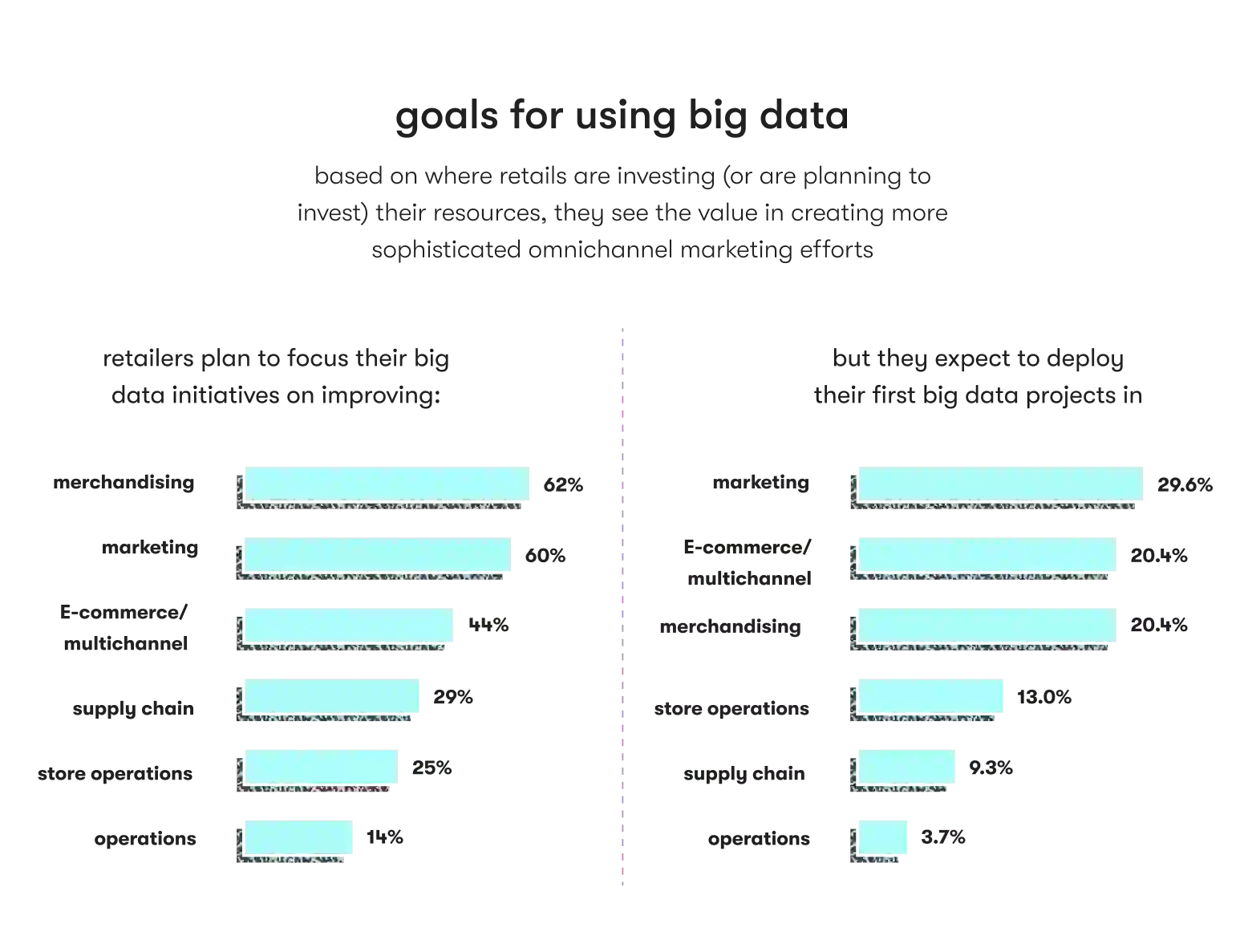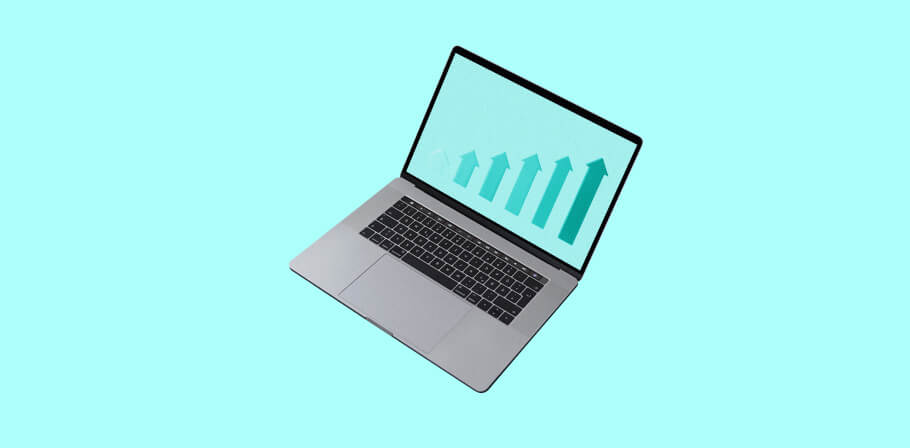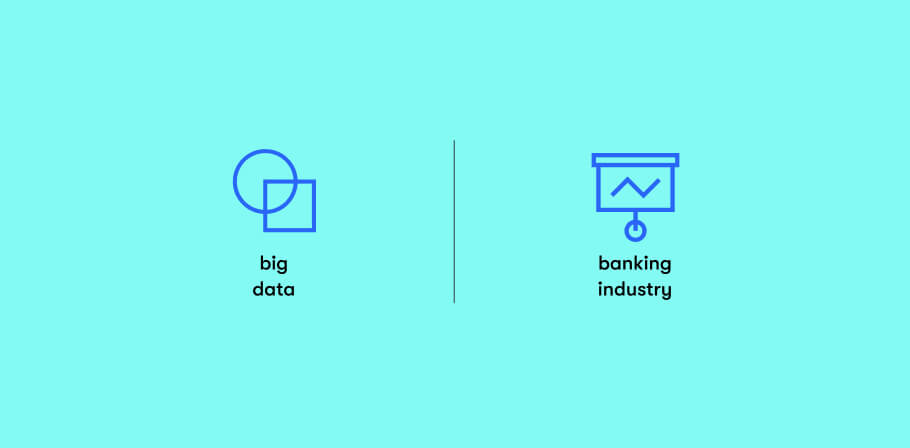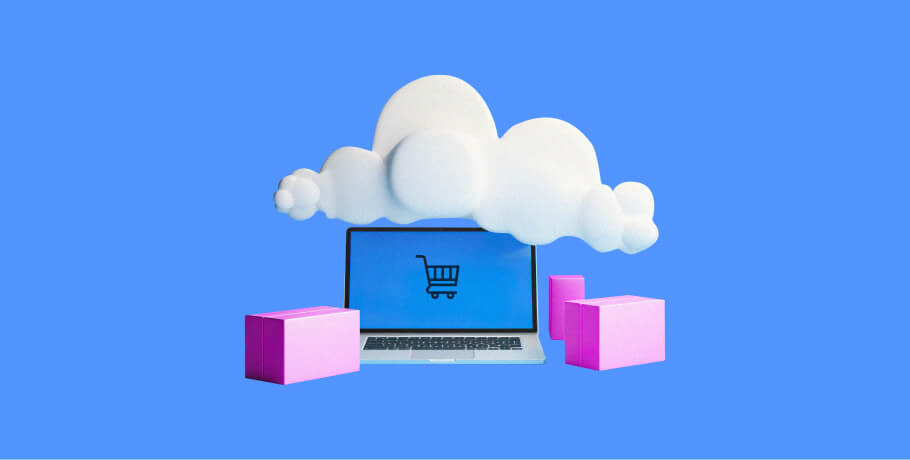The retail industry is a complex and volatile field that has been increasingly growing over recent years. The projections state that global retail sales are likely to reach $31.3 trillion by 2025. Staying afloat and managing to steadily increase profits require in-depth data analytics and a smart application of data-driven insights. Big data analytics has entered and revolutionized every industry, and retail is not an exception. But why do some companies manage to thrive and use technologies to advance and some still fail? In this article, we will go over the benefits of big data and knowledge management in retail, discover the most prominent examples, and take a look at successful applications of the technology.
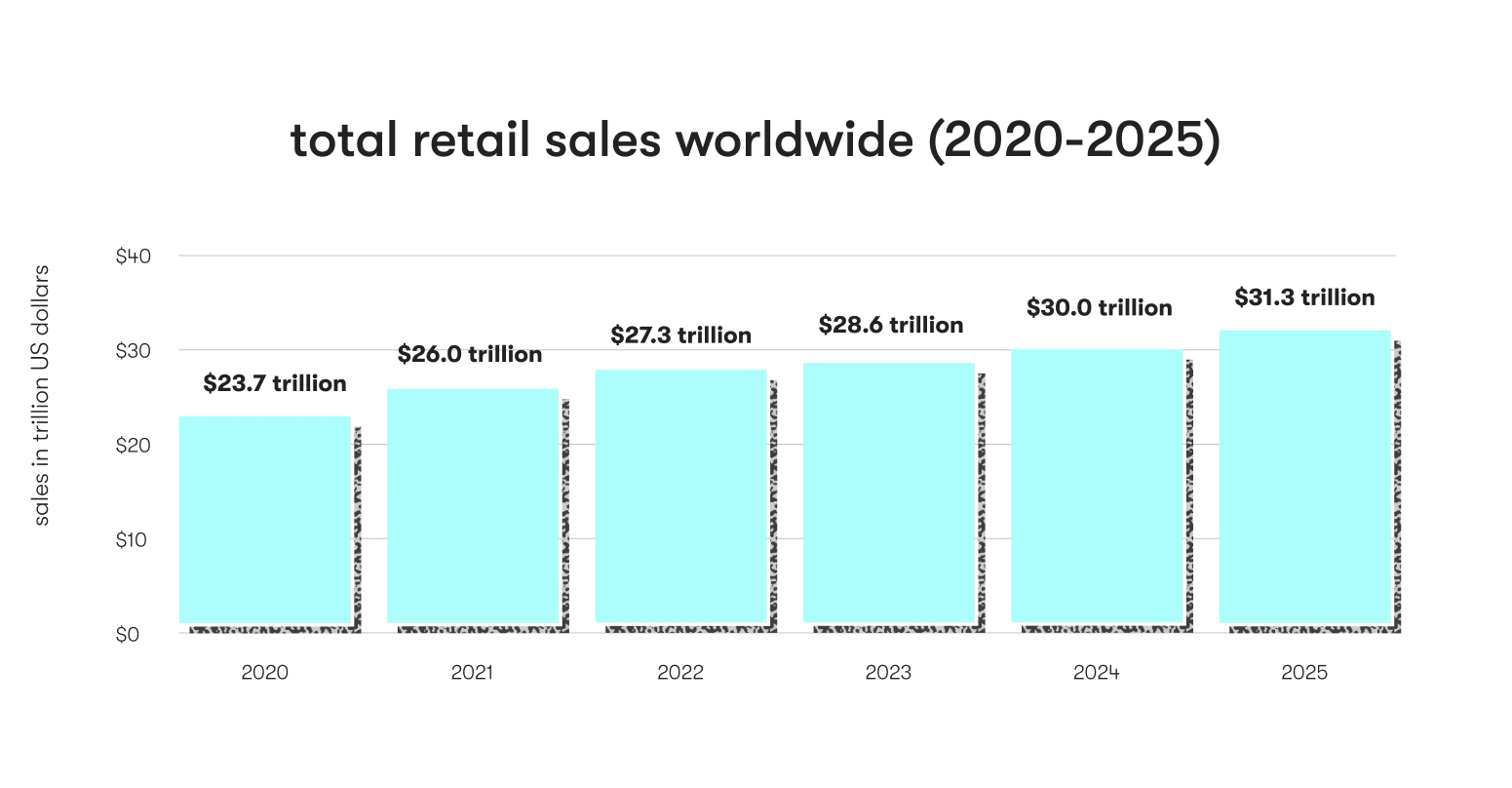
The Three V’s of Big Data in Retail
Big data is a broad term that can confuse non-tech people. Looking at the definition through the main concepts allows you to better grasp how big data in eCommerce can enrich retail and optimize your business. The three V’s stand for volume, velocity, and variety that shape the world of big data.
Volume
According to the projections, we will collectively generate 149 zettabytes in 2024. If a zettabyte is an unfamiliar concept to you, one zettabyte equals a billion terabytes. The volume of data created every day is growing and will continue to grow in the future. Obviously, data volume is an essential part of big data. Retailers also require large amounts of information to be able to analyze it and draw meaningful conclusions.
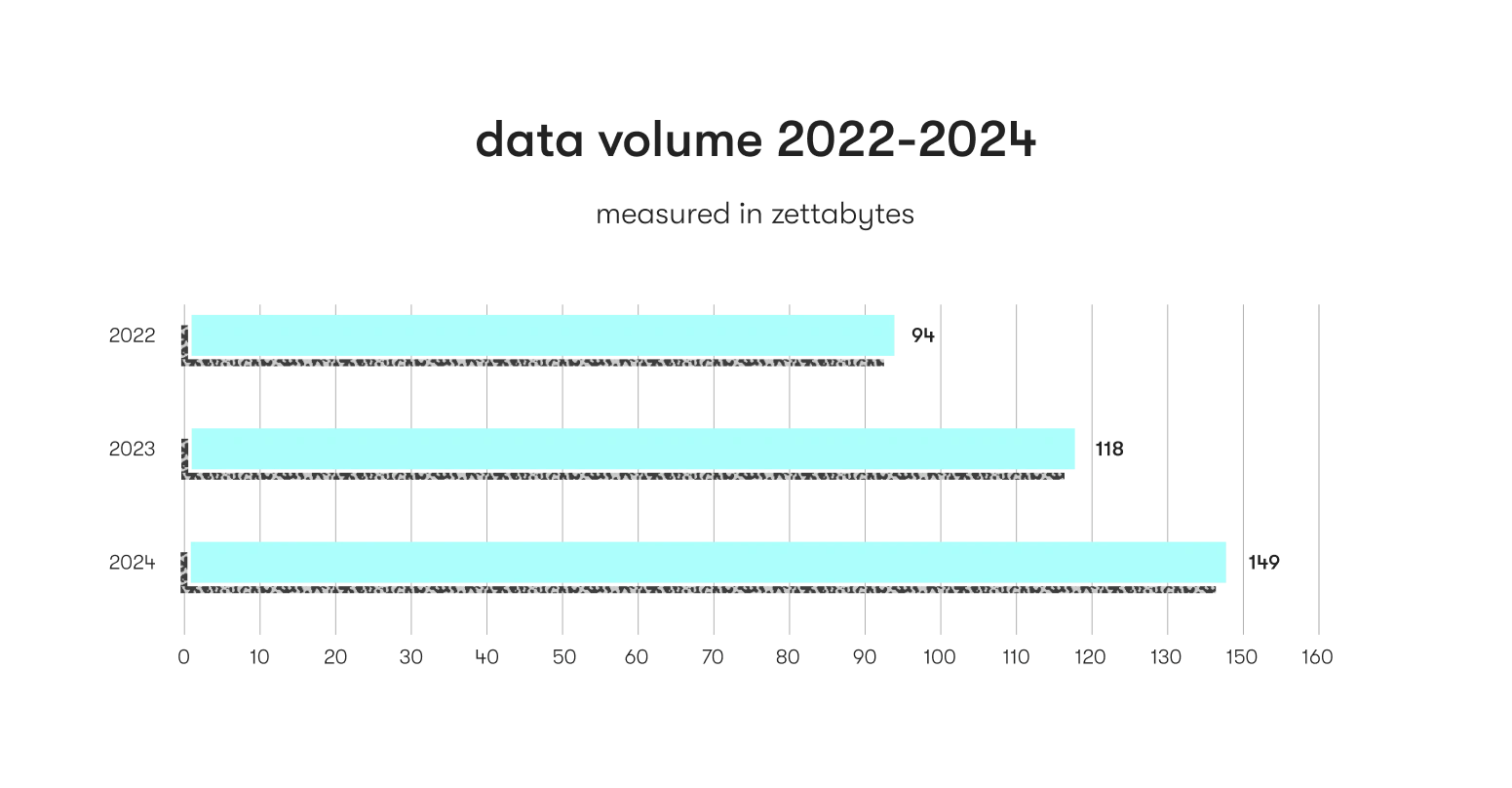
Velocity
Velocity accounts for how fast data is retrieved and collected, which usually depends on the type of business. To some businesses, analyzing real-time data is crucial for decision-making, whereas other companies collect data in batches. The colossal volumes of data need to be timely collected, processed, cleaned, stored, and analyzed.
Variety
Data nowadays comes in different shapes and forms such as video, PDF, text, graphics, and a lot more. Although having a variety is great for business, processing different types of data takes a lot more resources. This aspect of big data requires understanding the types of data, their format and usage, and the ability to process it in a meaningful way.
Key Benefits of Using Big Data in the Retail Industry
Big data analytics is essential for almost every business, especially in the retailing industry. But how exactly can your organization benefit from applying this technology? Simply storing vast amounts of data will not change your business for the better, but if utilized properly, it can give valuable insights. In this section, we will go over the most significant advantages of big data implementation in the retail sector.
Data accessibility
In the abundance of various devices that can access data nowadays, being able to collect information from all of them becomes crucial. Retailers need to observe customer behavior and purchase history from their computers, mobile phones, tablets, and other internet-connected devices. Retail and big data analytics allow us to consolidate and analyze info from any device, including wearables, and make data-driven decisions.
Personalization
Customers prefer personalized interactions and suggestions from brands and businesses as opposed to generic responses from the past. Knowing what your customer is looking for and their preferences allow companies to generate personalized messages, emails, discounts, special offers, and loyalty programs. Instead of randomly suggesting the most profitable or attractive products, big data and analytics for retail help us to create offers that would speak to the particular customer.
Customer segmentation
The costs of customer acquisition are notoriously high and unfeasible. Segmenting your customer base allows you to target clients that are more likely to complete a purchase. Attracting new customers and turning them into paying clients plays an important role in any marketing strategy; however, persuading existing customers to continue shopping with your company is more financially efficient.
IoT
The Internet of Things allows companies to produce wearable devices that generate even more helpful data. IoT devices are connected to the internet and capture customer behavior and actions data and send it to a centralized server. Using big data analytics for retail, companies have even more insightful information to sift through and adjust their marketing campaigns. You may also be interested in the article about IoT in retail.
Predictive maintenance
In the ever-changing world of retail, the ability to predict market shifts and customer behavior is a game-changer. Based on collected historical data, companies can make accurate predictions and determine how certain trends and events might affect customers. For example, what they will be likely to buy in case of a lockdown or sudden change of weather conditions. Knowing what your customer base wants and needs allows you to plan out the inventory and obtain a competitive edge.
Improved customer experience
Having access to customer data allows organizations to see user journeys and identify where customers get confused about the navigation and abandon the app or website. It could be small and easy to fix details that hinder users from completing the purchase such as bulky shopping cart previews, cumbersome payment gateways or unclear address form. Big data analytics helps determine which steps of the way make users abandon the shopping cart and solve this issue in the future. For example, autofill for personal information such as name, address and phone number in a food delivery app can significantly improve customer satisfaction and consequently sales revenue.
Price optimization
Finding the ultimate price for the product that will maximize the profits is not an easy task. The price will also fluctuate depending on the season and overall demand. Big data analytics can help you locate the perfect time to increase or drop the price and ultimately allows you to drive up the sales revenue.
Enhanced customer retention
Customer retention drops when users do not receive what they want and need and look for alternative solutions. In order to slow down churn, it is important to identify disengaged users and change their minds. You can ask for their feedback, offer personalized solutions and discounts, and come up with other tactics to make sure they stay with you.
Let your retail business take advantage of big data
Collect and analyze essential information, optimize processes, and boost customer satisfaction using top-notch technology. Consider working with our top talent to start your digital transformation.
The Big Data in Company Development
The market of retail includes various directions that can all benefit from big data tools. Retailers plan to focus their big data initiatives on predominantly merchandising, marketing, eCommerce, and supply chain. But which issues does big data solve when it comes to these elements?
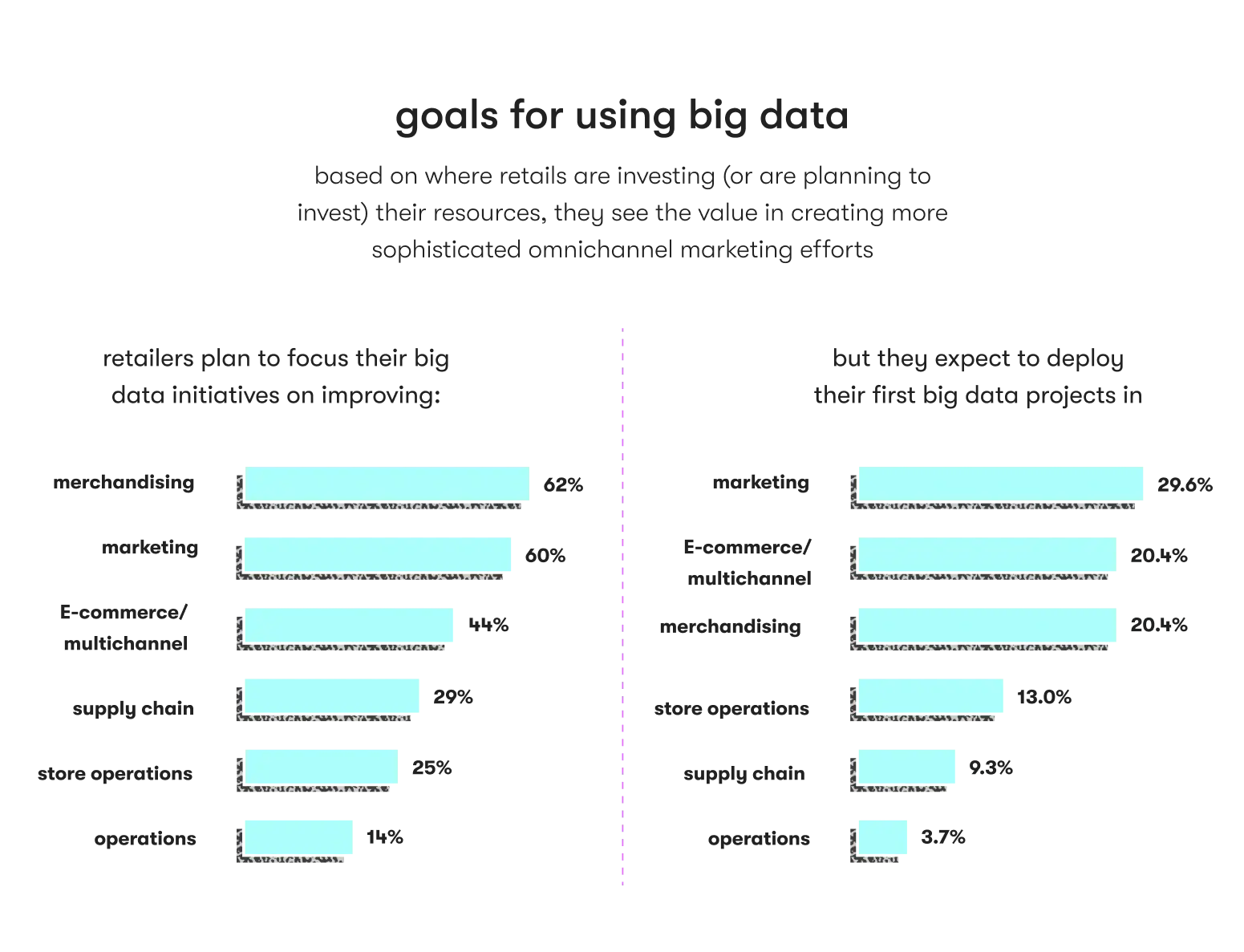
Supply chain efficiency
Supply chain management refers to actions that bring raw materials down the supply chain and turn them into final products. Establishing and nurturing good relationships with suppliers, partners, and customers is a vital part of supply chain management. By conducting retail data analysis using big data projects, companies can learn more about their vendors and evaluate their financial and performance metrics. Besides suppliers, it’s important to get to know your customers and their relationship with the brand. Data-driven technologies allow us to conduct sentiment analysis and learn what customers say about the product on various platforms.
Another benefit of applying big data analytics to supply chain management is inventory management optimization. Learning customer behavior and identifying market trends allows us to predict how much inventory will be required in a certain period. This way, you can avoid overstocking and understocking and prevent monetary losses.
Marketing and Promos
How big data is changing retail marketing analytics is by unlocking endless opportunities for improving and fine-tuning marketing strategies. First of all, you can break your customer base down into demographic groups that allow you to target specific customers. For example, you can separate your user base by age, location, gender, and more. Further, you can determine which types of content speak to your audience the most and move them down the sales pipeline. Customer data can also help you identify why customers choose to use or not to use your product. Finally, big data tools help marketers evaluate the success of marketing campaigns to improve them in the future.
Omnichannel sales
Omnichannel shopping experience has become an essential part of most brands. The majority of shoppers admit that they check the prices and discounts across various channels to find the best deal. Omnichannel shoppers are also more likely to spend more money on your products compared to single-channel customers. Research from CMO Council shows that 85% of consumers prefer having access to both online and offline experiences, or in other words, digital and brick-and-mortar.
Big data analytics can also help you manage inventory across all channels and make sure it’s balanced out and sensible. Omnichannel experiences allow you to offer cross-promotions and drive both channels through one another.
Financial analysis
Since the early days of eCommerce, the biggest concern has been fraud detection and prevention. Making sure the application is not hacked and not stealing personal customer data is the focal point of the application development process. Luckily, machine learning algorithms based on historical data allow us to recognize fraudulent behavior and detect patterns.
Data science also helps organizations analyze their financial data and identify the roadblocks that prevent them from exploiting potential opportunities. Retail business intelligence tools allow us to generate financial reports with valuable insights that can be utilized to help the company grow. Finally, the market itself fluctuates and fuels different trends, which can also impact your company's performance. Knowing these trends in advance facilitates early actions that can help you explore new opportunities and avoid bad outcomes.
Research and development
R&D is about coming up with new ideas that expand the company and improve the brand. However, some of these scenarios can have detrimental effects on your performance. Testing these ideas in advance without wasting resources and making sure they are a good investment is something you can do using big data analytics. Instead of relying solely on historical data, companies can utilize predictive analytics to build models and evaluate their R&D initiatives.
Risk management
Every business holds many risks that need to be continuously assessed and analyzed. For example, customer churn is one of the most significant risks that will definitely occur in some capacity but can be mitigated. Using big data, companies can forecast the risk of customer churning and take action to retain them.
Another common risk is untested third-party relationships that can severely jeopardize your reputation and finances. Data analytics can help you monitor the vendors and their performance and identify early signs of malicious activities. Finally, there might be some issues that drain your profits without you even knowing. Defects in production, unoptimized supply chain and other operational risks that heavily impact the end product can be detected and mitigated.
Utilize big data to take your company to the next level
Optimize your supply chain, conduct efficient financial analysis, and take risk management in your company to the next level. The team of EPAM Startups & SMBs will help you implement all the mentioned ideas and many more.
7 Retail Companies, the Pioneers of Using Big Data
More and more companies recognize the potential and impact of big data and utilize this technology to benefit their business. Especially big players with excess resources to invest in technology have shown impressive results from implementing big data analytics. Let’s check out seven retail companies that have successfully applied big data to enhance their performance.
Home Depot
The CMO of Home Depot, Kevin Hofmann, said: “Our data allows us to know our customer at a more individual level. Our targeting capability will help us get to them at the right place at the right time, and we aspire to have all of our messages be tailored to the audience”.
Home Depot’s big data investment allowed them to target their ads so precisely that even people from the same street will see different ads whenever they visit their website. They also experiment with weather-triggered advertisements that are only deployed under certain weather conditions. Additionally, Home Depot generates inventory-driven ads that are pushed forward depending on the inventory availability in certain stores. As a result, their online shop grew by $1 billion over the past four years, and the overall growth measured 20%.
Walmart
Walmart is one of the retail companies that use big data to identify the busiest times in their stores and pharmacies and optimize staff scheduling to accommodate their customers. The company also uses simulations to build optimized routes from the dock to the store and cut the duration of deliveries. Being a large store with millions of products, Walmart also decided to rethink merchandising to offer items that are sought after as well as new and discounted products. Finally, the retail company uses customer data to create a personalized shopping experience and anticipate the needs of its customers. Walmart has experienced a 15% increase in online sales which translates into an additional $1 billion in revenue.
Walgreens
Andy Kettlewell, the Vice President of Inventory and Analytics, said: “Data is critical for everything that we do at Walgreens, and with that data the customers are telling us what they buy and what they need.”
Walgreens is a drugstore chain that handles eight million customers in online and offline stores every day. By capturing and analyzing vast amounts of customer data, they can accurately manage their inventory and provide a better overall experience.
L’Oreal
Philippe Benivay, the Head of Experimental Data Intelligence, said: "Data and artificial intelligence allow us to move faster to create cosmetic products that meet the infinite diversity of beauty needs and desires of consumers around the world.”
L’Oreal is one of the retail companies using big data to drive their R&D and develop new formulas that appeal to their audience and market trends. They utilize data analytics to create new products and measure their performance among their customer base. The company has used the technology to also improve their KPIs and boost sales revenue.
PetCube
PetCube is an innovative pet tech company that develops software that captures and analyzes pets’ behavior and uses it to create an interactive video experience. Their inventions allow pet owners to play and talk to their pets and even give them treats using their platform and evaluate how the pet is acting and feeling to provide helpful insights to their owners. The product has already gained traction and attracted half a million dollars from Kickstarter as well as raised $14 million in seed, venture, and Series A.
McDonald’s
McDonald’s is a famous case study that utilized data analytical technologies to enhance customer experience. For example, they measure when large groups of people are likely to show up at the drive-through to accommodate them better. The company has also equipped their drive-throughs and restaurants with digital menus that allow customers to preorder and complete their purchases a lot faster. The digital menus display special offers and promotions based on the weather, time of the day and season, local events, and purchase history. The company has also implemented big data applications in retail to optimize inventory management, which is exceedingly more important for low-margin businesses like food service.
Nike
Nike collects customer data through their app, including additional solutions like Nike Training Club and Nike Run Club apps that analyze their fitness data and offer personalized guides for their workout sessions. The added value facilitates a stronger bond between the company and clients and encourages them to purchase fitness equipment and clothes that are tailored to their goals and experiences.
Nike went even further and invested in a product Nike Fit that scans customers’ feet to identify the perfect shoe style, type, and size. The app then stores this data to make personalized suggestions whenever the user shops online.
Netflix
Netflix was at the forefront of using big data to attract new customers and retain the existing ones. The company offers personalized movie and series recommendations based on what the user watched for longer periods. The algorithm can also predict which shows will become the new hit and which will remain fairly unnoticed. They also tailor the thumbnails and trailers depending on the person’s watch history and reviews.
The streaming service company also applies big data insights for its movie production strategies. For example, they can calculate the costs of shooting in one location versus another and identify how to streamline the entire process to minimize the expenses.
Adopt the lessons of the best retail companies
Experts of EPAM Startups & SMBs use big data to create robust personalization strategies for retail businesses. We provide big data software and application development services that help you enter the space of digital transformation.
Big Data Use Cases in the Retail Industry
If you are not as big as Netflix or Mcdonald's, you might be wondering how you can utilize big data. Let’s explore the most prominent applications and examples of big data in the retail industry and opportunities for ecommerce automation that you will benefit from.
360° View of the customer
This is one of the most prominent big data use cases in retail that allows companies to create dashboards that offer a detailed customer profile using data from different sources. The profile may include demographics, CRM data, and communication history with the company. The data may even include recent social media posts, search history on the company’s site and other important details. Customer service representatives can immediately access this information to provide a tailored experience and save their time. The data can even predict why the customer is getting in touch and offer solutions.
Fraud prevention
Big data in fintech allows credit card companies to make more accurate predictions, prevent fraudulent transactions, and improve their precision so that customers do not get calls every time they make a seemingly unexpected purchase. Since the company knows more about the client’s purchase history, they are more likely to accurately evaluate the purchase.
For example, instead of calling up the client because of a sudden purchase of an airline ticket, the company looks at the full history to determine the legitimacy of the purchase. If the client also booked a hotel or bought sunscreen or a suitcase, the ticket purchase does not look suspicious anymore.
Security Intelligence
Unfortunately, the development of newer and more sophisticated technologies does not stop hackers from successfully gaining access to company and user data. Big data analytics in retail delivers tools that can detect anomalies and alert the company and the customer about potentially fraudulent activity. Working in real-time, such tools use analytics and machine learning to identify unusual behavior and prevent people with bad intentions from stealing personal data.
Price optimization
Big data in retail helps organizations find the best price that generates the highest revenue for the company. Some models even allow companies to segment customers and analyze how much each customer is willing to pay for the product to adjust the prices accordingly. This strategy is not overwhelmingly successful in the B2C market but has become a standard in the B2B environment.
Operational efficiency
Operational inefficiency incorporates a set of potential issues that hinder the profits from going up. For example, a company tracks the sales of a new product at each point of sales and realizes that one store has not sold any items. Upon getting in touch with the store manager, they learn that they forgot to put the product on the shelf. Without big data analytics in the retail industry, the company would not have learned this information in time to swiftly fix the problem and would have lost money and product visibility.
Personalized recommendations
As we discussed in the Netflix example, the use of big data in the retail market allows companies to offer personalized recommendations that are more likely to appeal to the customer. This technology has become so commonplace that customers nowadays expect to see items based on their search and purchase history. Retailers that do not offer personalized recommendations will lose to their competition in the long run.
Internet of Things
The Nike example demonstrates a successful application of IoT to improve customer experience and drive up sales. These can entail big data solutions for retail firms that monitor customer movement or track the weather conditions and collect valuable data that is vital for customers’ purchase behavior. Using these insights helps companies to push forward the products that are most useful to the customer under the current circumstances.
EPAM's Experience in Using Big Data in Retail Software Development
EPAM Startups & SMBs is a team of experienced technologists, data scientists, and strategists that delivers digital transformation to businesses. Our expertise and acute knowledge of both business and technology allow us to take companies to the next level and unlock new exciting opportunities.
Take a look at one of EPAM’s top case studies below.
Edmunds Minsk Hackathon 2015: EPAM Big Data Innovation
Edmunds is a car-shopping guide that helps individuals choose the right vehicle. EPAM has organized a hackathon to brainstorm ideas on how to improve the car purchasing experience as well as increase the sales revenue for the car dealer. As a result, the team developed an app that tracks the prices and incentivizes customers to make a purchase whenever the price is down. Another achievement was a tool that compares the dealer's performance to their competition in their area. Finally, EPAM delivered a new feature to the site that allows customers to share their own posts about their cars with the important vehicle data that stays in the system and can be used to generate maintenance offers.
Epic Games
Epic Games is a game developer that produced one of the most popular games: Fortnite. Working together, EPAM and Epic Games created a digital platform for millions of gamers where they can communicate, track their experiences, generate friend lists and customize privacy settings. The game has become a large community of players that can enjoy the game and find like-minded people.
Telefónica Germany
Telefónica Germany is one of the largest telecommunication companies that came to EPAM to enable growth and insights for the future. EPAM developed solutions that help the company process large amounts of data while also drastically increasing the speed. The team also delivered a BI blueprint that allows the company to enter the big data analytics space.
Consider working with EPAM Startups & SMBs
Business to bolster your business in retailStart your startup or SMB digital transformation with one call. Contact our team to discuss your prospects and opportunities, as well as prioritize goals and get an expert evaluation of your project.
Conclusion
The ways big data and retail industry solutions can benefit your company, drive up the sales, and enhance customer experience are vast. However, the adoption of data analytics is not only about data storing and processing but also about how retailers use big data, extract valuable information and recognize the insights. If you would like to enter the digital transformation era and need assistance, get in touch with EPAM Startups & SMBs. We are a team of all-around experts who will help you go through a technological transformation and utilize the gained data to better your organization.
FAQ

Expert digital communicator and editor providing insights and research-based guides for technology buyers globally.
Expert digital communicator and editor providing insights and research-based guides for technology buyers globally.
Explore our Editorial Policy to learn more about our standards for content creation.
read more



